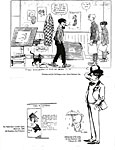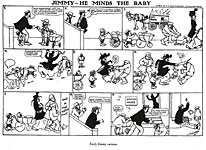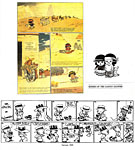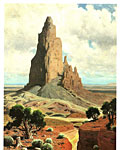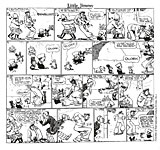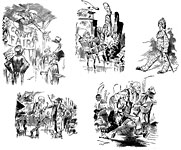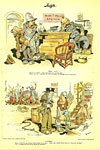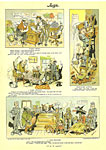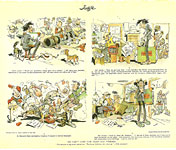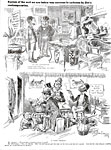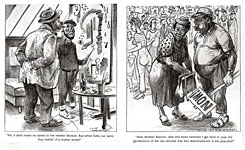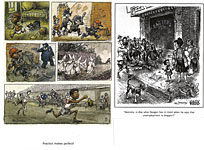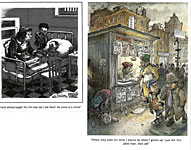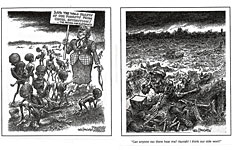|
SWIN,
ZIM AND OLLIE: A BRACE OF OLD MASTERS AND A NEW ONE Autobiographical comics notwithstanding, the lives of cartoonists, work-a-day and otherwise, may not much interest many of us who are not cartoonists. Or aspiring cartoonists seeking role models. A dubious proposition. Biography is always interesting. The lives of other people forever tantalize us, tempting us to pry and gossip. Every unexamined life is a scandal in the offing. But the biographies of those who practice in a particular field of endeavor have even greater interest than simple appeal to sensation-loving human nature: to the extent that the life of a cartoonist sheds light upon his deployment of the medium, so does his life have interest for critics and students of cartooning as an artform. Biographies of cartoonists have been conspicuous by the dereliction of their absence until a decade or so ago, when they emerged at last to become very nearly numerous. As the comics medium elbowed its way into the larger public arena—or, perhaps more accurately, as publishers perceived a market for such works in reports of vast throngs attending comic cons and buying graphic novels in quantity sufficient to make young millionaires of young artists—we have seen more and more biographies about cartoonists. Hal Foster, Charles Schulz, Milton Caniff, and, most recently, Alex Raymond—all giants in the profession who have rated expansive treatment between the serious hardcovers of scholarly tomes. And Hank Ketcham and Mort Walker both produced engaging and insightful autobiographies. These joined that rare few produced in Yesteryear’s less prolific era. Among the latter, for instance, is Harold G. Davidson's Jimmy Swinnerton: The Artist and His Work (Hearst Books, 1985), a slim 7x10-inch volume of 160 pages, bound on the short side, that presents Swinnerton the painter of desert landscapes rather than Swinnerton the cartoonist. Given Davidson's occupation as a dealer in the art of the West, the focus is understandable. But for historians of cartooning, it is regrettable that Davidson wasn't more versed himself in that artform. Moreover, considering that Swinnerton's chief source of income for most of his life was cartooning, to rehearse his life as if he were mostly a painter is wrong-headed as well as misleading. But Davidson's preoccupation with Swinnerton's painting is not at all disingenuous: Swinnerton may have made his living as a cartoonist, but he was passionate about painting and about the parched sund-drenched country of the Southwestern U.S., and he devoted much of his time to both. In that sense, the biography is an accurate reflection of the man. Coulton Waugh, the most venerable of cartooning's historians, cites Swinnerton as one of the three founding fathers of the medium. Waugh defined comics as consisting of three elements: (1) a narrative sequence of pictures in which (2) speech balloons are included in the drawings, the combination featuring (3) a character or characters who reappear with each publication of the feature. The last item snatches at sophistry. It’s there under false pretenses. Its function is purely rhetorical—to eliminate anything that came along before the Yellow Kid, the most conspicuous of the combatants in New York’s newspaper circulation battles of the 1890s. The Yellow Kid was seen as the first comic strip character mostly because he was a highly visible and successful commercial enterprise—the commercial aspect establishing the value to newspapers of comic strips. But “continuing characters” clearly have nothing much to do with the intrinsic form of a comic strip, and I usually leave that part out. For the sake of the present argument, however, let’s leave it in. For a few more minutes. The winning combination of all three crucial ingredients did not appear all at once, Waugh says, but was accumulated through the efforts of three individuals during the last decade of the nineteenth century. Swinnerton and Richard F. Outcault developed reappearing, continuing characters: Swinnerton with the Little Bears, Outcault with the Yellow Kid. Outcault was the first to employ a narrative sequence of pictures (Waugh says—although he has since been proved wrong in this) but Rudolph Dirks, with The Katzenjammer Kids, was the first to deploy sequential art regularly. Outcault was the first to put speech balloons within the pictures, but Swinnerton and Dirks developed the practice into a fundamental aspect of the form. Davidson ignores all of these matters, dismissing the issue with a single shard of syntax: "There are claims and counterclaims concerning who was the first cartoonist to draw a daily strip, and I won't add to the clamor." He allows, however, that Swinnerton was "one of a group of pioneer artists" who established the form. Despite this cavalier attitude, Davidson, in tracing Swinnerton's early career with the San Francisco Examiner, accurately records that the "continuing character" that Swinnerton introduced to newspapers was a small bear (subsequently named "Baby Monarch"). Intended to evoke the California state symbol, the grizzly bear, Swinnerton's little bear was devised to promote interest in the Midwinter Exposition that opened in San Francisco in January 1984. Reader interest in the bear, Davidson explains, prompted publisher William Randolph Hearst to direct the cartoonist to do several funny pictures of the bear to scatter throughout each edition of the paper. When the Exposition closed, the bear began appearing regularly in the "weather ears" at the top of the front page: in a box reporting temperatures and a forecast, the bear would carry an umbrella if rain were forthcoming or would be sunning himself on the beach. Subsequently, Swin, as he was often called, developed a comic strip about the bears and some little kids, called Little Bears and Tykes. Still later, after Swinnerton had left San Francisco (in 1899) and was working on Hearst's New York Morning Journal, he launched (in about 1902) another animal strip called Mr. Jack, which featured the doings of a merry bachelor lynx that readers persisted in calling a tiger, probably in the mistaken idea that Mr. Jack was supposed to represent the Tammany Tiger, the symbol for the more rapacious aspects of New York City party politics. (And the "tiger" label eventually got associated with the bears and kids feature, giving rise to Waugh's erroneous assertion that Swinnerton's earlier strip was called "Little Bears and Tigers." Tykes, tigers; close, but no cigar.) Early in 1904, Davidson reports, Swinnerton started doing a Sunday page about a little kid whose name was Jimmy. This was to be the feature most associated with Swinnerton as a cartoonist: it ran (called Little Jimmy when a daily strip version began in the mid-1920s) almost continuously until 1958, when Swinnerton retired from cartooning. (The daily version was discontinued in 1937, Davidson notes.) Interestingly, King Features continued to pay Swinnerton a weekly salary of $175 even after the cartoonist had stopped producing. It was Swinnerton's pension. (King did something similar with at least one other cartoonist, Otto Soglow, who did The Little King Sunday page.) In 1922, Swinnerton began drawing a two-page full-color feature for Hearst's Good Housekeeping magazine. Beginning with the May issue, Canyon Kiddies ran until December 1926, resuming as Kiddies of Canyon County in August 1933 to continue through April 1941. This feature probably embodied Swinnerton the man more than anything else he did. The "kiddies" were Navajo Indians, and the pages were made up of individual vignettes, each panel depicting the kids with desert animals or plants and including a few lines of appropriate verse. During the hiatus 1926-1933, the cartoonist did a similar feature called Near-to-Nature Babies, the title of which captures the spirit of the Canyon Kiddies, too. By this time, Swinnerton had become a desert philosopher as well as a painter, drawing from the arid scenery lessons about life to go with his paintings. Swinnerton's love affair with the desert began in 1906 when Hearst sent him to Colton, California (near Redlands and Palm Springs, on the edge of the desert and near the San Gabriel Mountains), where it was hoped the dry air would cure the cartoonist of tuberculosis. Swinnerton went to Colton to drink while awaiting his death; but he didn't die. He fell in love with the desert instead. And he started painting his paramour. The book uses a third of its pages to present a selection of Swinnerton's paintings: 49 out of 160 pages are full-page reproductions of his desert landscapes. Towering buttes and mesas and thunderhead clouds are rendered in flat color planes reminiscent of Gerard Curtis Delano's paintings of the same subjects. But by the end of his career, Swinnerton was creating scenes as luminous with reds and oranges and purples as Maxfield Parrish's work. Davidson furnishes many anecdotes about the desert painter, and he dutifully records the circumstances of Swinnerton's three marriages and a seven-year affair in Colton. He notes that as the cartoonist recovered from TB, he slowly gave up drinking and became quite philosophical about life and art. If we see Swinnerton the man here (which is the objective, after all, of any biography), we don't see the cartoonist as much as the painter. That's too bad, but the book provides nonetheless insight into the creations of one of the medium's pioneers. His pioneering was not as pace-setting as Outcault's or Bud Fisher's with Mutt and Jeff; for more on the latter, visit another entry in Harv’s Hindsight, dated November 2007. And Swin’s creations were not as thematically profound as George Herriman's, who also loved the desert, spent vacations painting with Swinnerton, and put wind-sculpted mesas and off-world buttes into the shifting, dreamlike backgrounds of Krazy Kat. Swinnerton’s visual artistry was not as impressive as Winsor McCay's or Cliff Sterrett's or, even, the latter-day George McManus. But his style was spare and clear, and that, compared to Outcault's sketchier renderings, set a fashion that others would imitate.
And speaking of footsteps to follow, we come to Eugene Zimmerman, the great Zim of Judge magazine fame. Zim was one of the giants of early (pre-newspaper comic strip) American cartooning, close on the heels of Thomas Nast, the revered father of American graphic editorializing, and Joseph Keppler, another of the patron saints of political cartooning albeit not quite so revered. Keppler had founded Puck, a weekly humor and political satire magazine, in 1877, and six years later, he hired Zim, but after two years, Zim left to join the staff of Judge and spent most of his active professional life there with Keppler's rival. An autobiography of Zim surfaced in 1988: published by something called Susquehanna University Press (or maybe it's Associated University Press, the title page bristles with competing possibilities), Zim is a fascinating but too brief volume (a mere 136 or so 8.5x11-inch pages). Apart from retailing many of the details of Zim's life, the book's interest lies in two areas, chief1y—neither of which would have been intended by the author. First, Zim's account of his youth offers shocking insights into the life of a poor immigrant boy in the last century. Born in 1862 in Basal, Switzerland, Zim was left there with relatives when his mother died two years later, his father, a baker, journeying to the United States to find work. Zim finally reached these shores at the age of seven. (His arrival, he says, was a surprise to his father!) At first he labored with his father in a bakery, and although he attended school until he was about twelve, he worked, too, at every available opportunity. At the age of twelve, he left the bakery for the more appealing outdoor work he found as a chore-boy on a farm. For the next three or four years, the youth worked for room and board and hand-me-down clothing. No monetary recompense at all. No wonder we needed child labor laws. At fifteen, Zim, who had always done a certain amount of drawing, attracted the attention of a passing sign painter, who took him on as an apprentice (in exchange for a bed and three meals and cast-off clothing again; no salary). His artistic career was thus launched. The same year, Puck began publication. By the early l880s, Zim was painting signs in Elmira, New York, and had seen enough of Puck to know he wanted to be a comic artist. In 1882 while visiting relatives in New York, he was persuaded to leave a portfolio of his work with them which they showed to Keppler. And Keppler was sufficiently impressed to ask that Zim come to town for an interview. He was hired for three years at $5 a week in May 1883. His career as a cartoonist was underway. A second area of unusual interest can be found in the well-intentioned but naive comments of the book's editor and compiler. William M. Brasch performed a heroic task in consolidating three autobiographical accounts that were found in Zim's papers, reconciling conflicting assertions and interspersing editorial commentary to provide social and historical context for Zim's narrative. All this is to the good. But Brasch begins to venture beyond his capacity as a scholar and historian when he turns to the racism and bigotry that Zim's drawings embody in their gross comic caricatures of Blacks, Jews, and the Irish. These cruel stereotypes were the common coin of comedy until well into the twentieth century. And Zim minted no new medium of humorous exchange when he depicted, as he frequently did, persons of these heritages in comic exaggeration. He was doing what nearly all his colleagues did. Writing in the 1930s, Zim comments on this practice: “Forty or fifty years ago the comic papers took considerably more liberty in caricaturing the various races than they do today. Jews, Negroes, and Irish came in for more than their share of lambasting because their facial characteristics were particularly vulnerable to caricature.” That's how he explained his racist pictures to himself: their faces were funny enough in nature to be even funnier if caricatured. This is a cartoonist talking, not a racist. It's a man looking for comedy. And he's looking in places where the show business of his age also looked: in vaudeville and minstrel shows, Blacks and Jews and Irishmen were often figures of fun. Zim is very much a man of his times (he could scarcely be a cartoonist otherwise), and in his day, racism was so much a fact of ordinary life that many were not even aware that they were racists. In short, Zim was no more racist than any other white person of his time. Which is another way of saying that they were all racist. But they probably didn't realize it. Many white folks didn't. They were blind to their faults. A not uncommon failing. Even today. The book includes a sampling of Zim's work in this arena. No, I don't think the sense of humor displayed in these vicious caricatures is praise-worthy. Nor do I intend by publicizing the existence of this volume to prolong the vitality of the stereotypes Zim's cartoons trade in. Those of the politically correct persuasion who chance upon these pictures will be appalled, of course. And well they should be. We all should be. But hiding the pictures in the closet denies that they ever existed. Not only would we be denying our past, we would be denying the evil in our past. We would be misrepresenting our history, lying about ourselves. And if we do not occasionally recollect the things we did of which we are now ashamed, we will not be equipped to avoid repeating the same sins in the future. "He who knows only his generation remains always a child." Upon this principle is founded all of the Jewish Holocaust literature and liturgy. Brasch, who tells us that he is a member of one of the ethnic groups Zim depicts so grossly, sounds a somewhat apologetic note in his Introduction as he searches for some explanation for Zim's heavy reliance on racial stereotypes in his cartoons. It's as if he hopes to uncover something that will excuse Zim's racism. Nothing excuses it, of course, but such explanation as there is can be found in Zim's own words (which I've just quoted) and in the history of the times. Brasch notes the latter but somehow overlooks the former. Brasch dutifully records that times change, and he observes that Zim changed with them: in penning his autobiographical notes during the 1930s, the cartoonist remarks that "only the most stupid publishers" would publish the kinds of racist cartoons everyone was publishing at the turn of the century. In seeking to excuse or explain Zim's racism, Brasch is indulging a charitable and kindly impulse, and I admire him for it. And certainly no one could write a book about Zim without acknowledging the racism that infected his cartoons during a major portion of his career. But then Brasch leaps from acknowledgment to the assertion that the reason Zim's work is almost unknown today is that we are ashamed of the racism in our history (and in Zim's cartoons) and now wish to ignore it out of existence. Here, Brasch reveals naivety and ignorance about his subject. In the first place, Zim is not alone among the Great Forgotten of American cartoonists. Few of his contemporaries are remembered clearly today. Thomas Nast is about the only name that we could expect the average American to recognize in a list of Zim's fellows—a list that would include Bernhard Gillam and his brother F. Victor, E. W. Kemble, W. A. Rogers, James A. Wales, Grant E. Hamilton, and Louis Dalrymple, to name a few. Only Charles Dana Gibson raises his head above the mists of history in common memory. Brasch merely flaunts his ignorance when he tries to make his point by comparing Zim to other "forgotten" men—Bud Fisher, Richard F. Outcault, George Herriman, Winsor McCay, and Rudolph Dirks. Who, asks Brasch, remembers any of these great early cartoonists? Most of you reading this, probably. The man-in-the-street may not know who McCay or Herriman was. But the man-in-the-street is notoriously ignorant of many of the most ordinary facts of history; he can scarcely be invoked as a reliable indicator of an entire culture's collective memory. In assuming that McCay and Herriman and the rest have disappeared from our history, Brasch betrays his own shortcomings as a historian. Zim may not be as well remembered as the newspaper cartoonists of his generation, but he is not neglected any more or less than his humor magazine brethren. They are all forgotten. Or barely recollected. And that's because much of the humor in their work is obscure now. Their cartoons refer to aspects of life that we no longer readily recognize. And as our schools graduate more and more people with less and less knowledge about their country's history, that situation is not likely to change much. Zim and his nineteenth century contemporaries are simply not easily accessible to the average reader in the closing years of the twentieth century. Probably they have not been very accessible for the last half of this century. Granted, during at least a portion of that time, we would probably have felt uncomfortable with the obvious racism of Zim's cartoons (as we would with the racist cartoons of many of his colleagues). That is, at least some of us would have. But the real reason Zim is not any more well known today is that the comedy of his cartoons in general (which includes their racism but is not restricted to it) evades the modern reader. And the form of the cartoons of that time is also unfamiliar to us. The multiple-speaker cartoon—the single drawing with a series of speeches printed below it—seems primitive, crude, not very funny. The humor sidles up to you instead of exploding with a bang. The modern single panel cartoon (in vogue since the late 1920s) with its pungent single-speaker caption seems much funnier because the point of the joke takes us by surprise: only by linking the meaning of the words to the significance of the picture can we make sense of both, and at that instant of manufactured coherence, we are surprised—and we laugh. But we don't laugh much at the "old fashioned" cartoons with several lines of caption below the pictures. We smile maybe but we don't laugh. And since we prefer to laugh, we don't search very diligently for cartoons of the kind Zim and his compeers wrought. And since there's no search underway, there aren't many reprint anthologies of old time cartoons. And that's too bad. Particularly with Zim. It's too bad we don't get to see the lively exaggeration of his compositions. Here, probably more than with many of his fellows, Zim excels. In fact, he was among the first cartoonists to draw in what we now regard as a cartoon manner. Many of his colleagues were illustrators, not cartoonists. Gibson, for instance—famed for his penwork and the glacially beautiful "Gibson girl"—drew in quite a realistic style. So did Nast and Kemble and many others whose work was published in the humor magazines of the time. Their work was elaborately detailed, their lines thoroughly cross-hatched, the impression realistic. Many of them did work for the humor magazines Puck, Life, and Judge (to name three of the many that flourished through the latter half of the nineteenth century) almost as a supplement to the greater income they derived from illustrating short fiction in magazines like Leslie's Monthly or Harper’s Weekly. But Zim was pretty exclusively a cartoonist not an illustrator. Although he illustrated some books, his "illustrations" were usually cartoons. His drawings were cartoons because their juicy line-work was simpler and because he exaggerated human anatomy for comic effect. I don't know enough about the period to know if Zim was the first to hit the funnybone by striving for simplicity and exaggeration in his drawings. Others were doing something of the same thing by the first decade of this century. Art Young, for one—whose simplicity of line is very modern indeed; see February 2004's Hindsight for more about Young. But Young’s proportions—his caricatures of humanity—were much more restrained in comparison to Zim's bigfoot oeuvre. The same might be said for James Montgomery Flagg, whose Nervy Nat was a comic exaggeration even if the rest of the cast of that feature was usually depicted rather realistically. (Flagg, by the way, came to regret his early career as a "cartoonist," and in later life, he would very nearly deny he had ever drawn such things as cartoons.) But it was Zim’s propensity to exaggerate that made his drawings cartoons. Only T.S. Sullivant of Zim's contemporaries distorted human anatomy with such comic abandon. In Zim's work, we have striking examples of what funny pictures really are. And we should rejoice in them. We also have another clue to Zim's penchant for doing cartoons about racial types. In Zim's eyes, remember, the facial features of certain minorities lent themselves more readily than others to caricature—to exaggeration. Since his forte in drawing for humor magazines became exaggerative drawings, it is natural that he would resort (perhaps more than many of his fellows) to what he perceived as the highly comic facial characteristics of those who "looked different." Again, I do not claim that Zim was not a racist. By our standards today, he clearly was—he and most whites of his time. But his impulse was towards comedy not contumely. He aimed to provoke laughter among his readers not prejudice. Unhappily, Brasch's book, although copiously illustrated, doesn't show Zim's work to advantage. The reproduction of many of the vintage black-and-white cartoons is flawed: it looks as if they were printed from third or fourth generation photocopies instead of directly from the pages of old copies of Judge (or directly from high quality photocopies of those pages). Many of the fine lines have disappeared or matted together, forming blobs of black instead of shades of gray. The book includes many drawings Zim made in the early 1920s expressly for the purpose of illustrating his autobiography, and the simpler line-work of these fares better in reproduction here. And an 8-page color section is superb. But sadly the pictures from Zim's years of greatest achievement suffer. Here are some of Zim’s cartoons not in Barsch’s book; these appeared in Judge between July and December 1903.
Before leaving Zim and his autobiography, I must note another curiosity in Brasch's introductory comments. Noting great gaps in the story of Zim's life, he ponders about what Zim left out of his autobiographical notes, speculating that the omissions constitute some kind of cover-up for a dark secret in the cartoonist’s life. Here again Brasch reveals his own unfamiliarity with the territory. Most cartoonists in telling their own stories follow a similar pattern: they dwell in loving detail upon the events of their youth and upon the mechanics of any jobs they held before they became cartoonists full-time. Then, once their narratives reach their cartooning careers, they typically fall silent. Brasch finds this suspicious. He imagines that Zim is hiding something. Perhaps, as Brasch notes, Zim doesn't talk much about his wife because he had an unhappy marriage. But perhaps he avoids the subject because he thinks his readers would not find it interesting. Many cartoonists do the same when telling their stories. Hank Ketcham doesn't discuss his domestic travails in his autobiographical The Merchant of Dennis (and there were travails he could have discussed, too); discretion and modesty prevailed. Ketcham, however, talks more about the art of cartooning than most other cartoonists writing about themselves; so does Mort Walker in Backstage at the Strips, still perhaps the best book on the subject. But most cartoonists skimp in telling about that portion of their lives spent hunched over a drawing board. And they doubtless do so because they believe the average reader would not be interested in the tiny triumphs and the tedious catastrophes that they encounter with pen and paper. They're probably right: only passionate fans and other cartoonists are likely to be interested in such matters. And so most of them—like Zim—steer away from the quiet waters of their own daily lives as cartoonists and navigate instead into the roiling surf of the lives of the rich and famous they have encountered. Zim talks about the progress of the magazines he worked on—Puck and Judge—and the craft and careers of Gillam and Keppler and Hamilton. Although he doesn't give us much insight into what the life of a full-time Judge staffer was like, we glean an inkling or two from what little he does say. He discusses the politics of the time—the battles of which Judge was so much a part. And he talks a little about his own progress, his success when he moved to Judge in getting his work published in the premiere positions of the magazine rather than in the back pages. But mostly, he barely mentions his own affairs (financial, professional, or otherwise, if any). However that's not a matter for suspicion, as Brasch would have us believe: it's merely the mark of a modest man, who, despite his facility with words, is doubtless not accustomed to writing as a mode of self-expression and who therefore cannot easily lay his hands on what he regards as an interesting way to describe his professional life. Few cartoonists can. Nothing to remark upon in that: it's probably normal. Taken as a who1e—despite its flawed reproduction and some faulty editing—Zim is a valuable addition to the reference shelf on American cartooning. Zim doesn't tell us much about himself as a practicing cartoonist, but he reveals much about the work and lives of several other cartoonists of his time and about the humor magazines for which they worked. And in his brief comments on the matter of racial stereotyping we can glimpse a truth about the racism of his times that is much less malevolent than we might otherwise have supposed. Another cartoonist whose career was built on racism is Ollie Harrington. In Harrington's case, however, the career was a fervent crusade against—rather than a comedic exploitation of—bigotry and racism. Harrington aimed to correct and reform rather than to amuse in manner of Zim and other turn-of-the-century cartoonists. And in two productions from the University Press of Mississippi (3825 Ridgewood Road, Jackson, MS 39211) a few years back, we find the crusader in verbal as well as visual dimension. In Dark Laughter: The Satiric Art of Oliver W. Harrington (160 7x10-inch pages), we have a judicious sample of Harrington's panel cartoons, both gag and political, from the 1950s through the 1980s. Why I Left America and Other Essays (148 5x8-inch pages, still available from upress.state.ms.us for about $19.95) collects a number of essays Harrington has written over the years, including the title piece. Both books are edited by M. Thomas Inge, who provides thoughtful Introductions to each. Lest it not be entirely clear, let me assert immediately and unequivocally that Oliver Wendell Harrington is one of the five greatest Black practitioners of the artform and one of the most powerful of all American cartoonists regardless of race. He is also the most neglected of the Black quintet, the most overlooked. George Herriman is doubtless the most sublime artist of the group, his lyric Krazy Kat having ascended to metaphysical poetry. Matt Baker is probably the best draftsman in this company, particularly in rendering the beautiful women with which he populated his comic book pages. Jackie Ormes, like Harrington, was a crusader cartoonist, particularly in Torchy Brown strips. (An Ormes biography appeared last year, reviewed at Opus 219.) And E. Sims Campbell was surely the most successful in terms of public acceptance and (probably) financial reward; see Opus 155. But if Campbell is a great Black cartoonist (and he is), it is not because he was an advocate for racial equality: Campbell was great because he was funny and immensely successful in spite of his race. Although he drew editorial cartoons on racial issues for Black newspapers in the 1930s and 1940s, he achieved his greatest success drawing for mainstream publications. And he succeeded in a racist society by drawing for a white audience—pretty girls, most notably, in Esquire magazine (the famous harem girl cartoons in luminous watercolor, which also were a feature of the next generation's men's magazine, Playboy) and in newspapers (Chorus Cuties, a panel cartoon syndicated by King Features). Harrington was never as financially successful as Campbell—nor as visible on a national scale. But Harrington was—and is—a heroic figure. Only Ormes, by tackling sensitive issues of race and gender in Torchy, approaches him in this respect. In comparison, however, Harrington looms much larger over the crusading landscape of cartooning. In his Introduction to Dark Laughter, Inge provides a brief history of Black cartoonists in the U.S. and then sketches in the main outlines of Harrington's life. Born in 1912 in Westchester County north of New York City, Harrington grew up in the South Bronx, to which his family moved when he was seven. After graduating from high school, he freelanced and by 1932 was getting his cartoons published in Black newspapers. He was also living in Harlem, then in the final flowering of the cultural and literary outpouring known as the Harlem Renaissance. Harrington became friends with several of the writers of the period—Arna Bontemps, Rudolph Fisher, Wallace Thurman, and Langston Hughes. He took classes at the National Academy of Design, and his cartoons were published in the leading Black newspaper of the area, The Amsterdam News, as well as in Baltimore's Afro-American and Pittsburgh's Courier. In May 1935, he began a series of gag panel cartoons called Dark Laughter about urban life in Black America. And at the end of that year (on December 28, to be exact), he introduced in the feature a heavy-set bald Black man who soon took over the panel, becoming the most famous of Harrington's creations. This was Bootsie, and Harrington would draw cartoons about Bootsie more-or-less continuously for the next three decades. As Inge observes, Bootsie "finds himself at the center of some comic situation which he has either initiated or unwittingly walked into. A lover of fine soul food, liquor, and women, either by comment or silent witness, he reflects on the fads and foibles of the urban Black community, and as often as not, he himself is the butt of the humor. Racism and conflict with the white community frequently serve as the main topic, but much of the ridicule is directed at Blacks themselves and the way they treat each other. It is this internal satire that moves the target of the humor in the direction of human nature and gives Harrington's comic skills the broadest social relevance and universal applicability." Harrington enrolled in Yale University's School of Fine Arts, graduating in 1940 with a BFA. In 1942, he was hired as art director of Adam Clayton Powell Jr.'s new weekly newspaper, The People's Voice. He drew editorial cartoons, Dark Laughter, and a continuity strip about a newspaperman called Jive Gray, and he illustrated several installments of Richard Wright's Native Son, which Powell began running serially. But Harrington left the paper within a few months to work for the Pittsburgh Courier. For that paper, he reincarnated Jive Gray as a Caniff-style wartime adventure strip, and he also went on the road as a correspondent to visit military installations and report on the contributions Blacks were making to the war effort. In this capacity, Harrington went to North Africa and then to Europe. In Italy, he met Walter White, then an executive with the National Association for the Advancement of Colored People (NAACP), who, after the war, persuaded Harrington to join his staff to create a public relations department. While with NAACP, Harrington appeared in a public forum to debate U.S. Attorney General Tom Clark, who had launched a federal investigation of the lynching of four Black men in Georgia but had been unable to secure any convictions. Harrington confronted Clark with the fact that "there has never been a conviction in the history of the U.S. for the crime of race hate and lynching." The cartoonist went on to ridicule "the greatest secret service agency in the world" for being "unable to find a single clue" or to locate "a single criminal" in a series of vanda1isms in a Tennessee community of Blacks. Later, Harrington would come to believe that this attack resulted in Clark's labeling him as a Communist, and that, in turn, forced him into exile in Europe. Shortly after Joseph McCarthy began his fanatical ferreting out of Communists in government in 1950, Harrington left the country and went to Paris. He had been warned by a friend in Army Intelligence that he should take a vacation "until this thing blows over." In Paris, Harrington joined an enclave of Black American artists and writers that included Chester Himes and Richard Wright. He remained Wright's closest friend until the novelist's mysterious death in 1960. Harrington, a raconteur of the first water, was soon the center of the café society in which the expatriate Blacks moved. He studied art and he continued contributing cartoons to Black newspapers in the U.S. He also did some freelance illustrating, and in 1961, while Harrington was in East Berlin to discuss an assignment with a publisher, the East Germans closed the border and built the Wall. Harrington was trapped: he didn't have the proper papers to cross the border. For the next thirty years, Ollie Harrington lived and worked (and eventually married) in East Germany. He continued sending cartoons to the U.S.—political cartoons now, savage attacks on institutionalized racism and mindless imperialism and self-serving politicians, which were published in the New York Daily World (later called the People’s Daily World). He did cartoons of the same ilk for East German periodicals, too—the humor magazine Eulenspiegel and the general interest magazine Das Magazine. For these publications, he often drew his cartoons in brilliant full color. In addition to 30 full-page Bootsie cartoons, the Dark Laughter volume includes a healthy 25-page sampling of these political productions, many in color wherein Harrington displays mastery of the medium, using delicate tints and hues with panache. The black-and-white Bootsie drawings are an impressive demonstration of the cartoonist's skill with grease crayon and pebbleboard, subtly shaded renderings all. And these, given Bootsie's longevity and presence in the Black communities, are of great historical value. But it is Harrington's political cartoons for the Daily World (beginning in 1968) that are the most forceful of the undertakings published here. With bitterly ironic humor, Harrington attacks racism, homelessness poverty, insensitive politicians, and bloated capitalists. One cartoon shows Ronald Reagan as President at a fully miked podium under the portico of the White House. In front of him stand ranks of policemen, nightsticks at the ready; in the distance, we can see an ostentatiously long limousine crossing an overpass under which huddle a pair of homeless men, warming themselves on an open fire. The caption: "State of the Union." Reagan is Harrington's target often. Another drawing shows a knot of people gathered around a man who has fallen to the sidewalk (weakened by starvation, we assume). An observing child asks his mother, "Is that what Reagan has in mind when he says that unemployment is dropping?" Another cartoon takes five panels. It shows a little kid running from a rat in his bedroom, running from bullies on the street, then—older now—running from the police, then running from the Ku Klux Klan; finally, in the last panel, the kid is an athletic youth, winning a footrace in a track meet. The caption: "Practice makes perfect." Harrington's spokesmen are frequently children, who (as we all know) see the world clearly (and know when the emperor has no new clothes). In a caption1ess drawing, a fat old lady carries a placard demanding that we “save the wild beasts of our forests from cruel extinction.” She is surrounded by skeletal, starving black children. A color cartoon takes up the same theme, showing a couple of white tourists photographing an emaciated naked woman and her skin-and-bone child. The white woman says, "And remember what the photo instructor always said—in bright sunshine, always use a fast shutter." This kind of irony—blatant and bitter, raw and painful—is found in many of the cartoons, often with a focus on idiocies other than racism. In another color drawing, Harrington gives us a street scene in Grenada. Two military officers are strolling along, oblivious of the scene on both sides of them—citizens lined up against a wall being frisked by the police, impoverished children working for pennies shining shoes, starving dogs, sex being sold. One officer says, "You boys done a great job bringin' democracy to the island, Cap'n. Looks like back home already." Yet another cartoon shows a giant bomb in the midst of a wasteland. Two cockroaches are in the foreground, and one says to the other: "That one didn't go off but 60,000 others did—though 200 would have emptied the planet anyway." And then there's a skeletal soldier surrounded by dead bodies and bleak devastation, speaking into a radio transmitter: "Can anyone out there hear me? Hurrah! I think our side won." Mainstream political cartoons seldom hit as hard as these cartoons of Harrington's. The drawings are gritty renderings, their lines ragged and shading scratched coarse in comparison to the Bootsie cartoons. The technique fits Harrington's subjects and his point-of-view. There's no compromise here. No soft shadings, no nuances or grays. And no laughter. These are tough, one-sided statements, deadly serious and entirely unequivocal in rhetorical stance.
It is not surprising that Harrington's work was so well-received in East Germany. Although he was soldiering in the common cause of humanity at large, the forces of Communism could easily use his weapons in propaganda campaigns against the U.S. because so many of his targets were rooted in the sins of America (whether racial, imperialistic, or capitalistic). I doubt that Harrington saw his work as political in quite this sense; nor would he see himself as being “used” in the Communist cause. (And even if he did, he surely knew he was "using" the Communists in turn: with every cartoon they published, he struck a blow for decency and compassion, without regard for national politics.) In starkness of treatment and overt bitterness of statement, I can think of only a few American cartoonists ·whose work compares. Some of Art Young's stuff for New Masses magazine. Some of Daniel Fitzpatrick's shrouded cartoons for the St. Louis Post-Dispatch. Some of Bill Mauldin's post-World War II productions (see Harv’s Hindsight, February 2003). Cartoons done for advocacy periodicals—labor papers, for instance—are sometimes as straight-forward and unvarnished. Given Harrington's subjects—the offense to common sense and decency that his targets have committed—it may appear that the moral edge of his cartoons is relatively easy to achieve. Few would argue with his point of view. Most thoughtful persons share it. To a great extent, he is lecturing to the already persuaded. But the vividness of his visual metaphors is the product of an inventive imagination as well as a moral passion. Although the images seem—now, as we see them before us on paper—obvious to the point of commonplace, they are nonetheless powerful. And they were doubtless not arrived at as easily as we might suppose. Preaching to the converted, Harrington was a kind of cheerleader rather than an evangelist. His message was readily accepted by decent people. But this does not diminish what he did. We need such cheerleaders, persons who keep our passions alive, who fuel the outrage and thereby advance the cause. The essays in Why I Left America shed light on Harrington the man as well as on the milieux in which he lived and worked. Taken altogether, the essays cover key moments in his life--the unfeeling teacher who introduced him to racism, life in pre-War Harlem, his correspondent service in the military, his work for NAACP, and his exile. The longest essay is "Look Homeward, Baby." Lighter in tone than some of the others, it brims with "signifyin"'—a teasing, kidding rhetorical posture—in heartfelt anecdotes about life in Harlem in the thirties and in Paris after World War II. The same tone pervades "How Bootsie Was Born," which is more about Harlem than Bootsie (but that's how he was born). In one essay, Harrington tells us about "good old Harris," one of the expatriate American Blacks he met in Paris. Harris aspired to be an artist, and when he found out Harrington was studying art at a nearby academy, he wanted to know how to go about it himself. He was told to buy a beret and some drawing paper and charcoal and a drawing board and then go to the art class and do what everyone else was doing. Harris did all that and went to the academy's life drawing class. Busying himself setting up, he didn't notice what else was going on in the room until he sat down at his drawing board and looked up. And there on the platform in front of the class was the model, a nude white woman. Harrington finishes the story: "Now, old Harris was from Mississippi. To be suddenly faced with this naked white lady was too much for old Harris. He reached down and slapped his beret on his head and packed up his stuff and flew out of there. It took us a long time to explain to Harris [that what he had seen was normal in a life drawing class] and to convince him that there was nothing to it, that [no one was] trying to trick him." The book contains several similar episodes with racial overtones, including a few instances of the kind of senseless racial violence that lynchings and mutilations in the South once represented—and some instances that while not physically violent still sear the soul. Occasionally Harrington simply asserts that an individual was mistreated solely because he or she was Black. Usually in such cases, he presents no "evidence" for his conclusion. He simply states it as a fact. Bigotry is like that: it exists without the support of fact or reason. But logic demands fact and reason. And in consequence, upon reading these passages, I reacted at first to these bald assertions by thinking, "Okay—I know racism and bigotry exist, but where's the evidence for it in this particular instance?" And then I reflected that racial harmony cannot be achieved without trust, and my studious demand for evidence signalled mistrust: without evidence, I would not believe. For the sake of building trust, I stopped looking for evidence. Racism exists; we all know it. So why quibble? The gap between ordinary human beings is great: we are all essentially solitary souls, living in isolation. The gap between races is greater: one might be trying to trick the other, as old Harris believed. But that gap must be bridged, and the bridge is trust. We must all earn that trust, white and Black alike. Only when we have learned to trust each other, will we live together in harmony. And trust, sadly, takes longer to learn than just about anything in human relations. Strictly speaking, these Harrington books are not biography. But the story of the man's life as well as his work is on display, and that's biography enough. Knowing aspects of his life enables us to appreciate even more the work. And knowing more about both may help cultivate trust. If we are very lucky, in some distant future, we may read Harrington's anecdote about old Harris and not laugh: we'll fail to see the humor because we will no longer understand the context of mistrust upon which it is built. Not so impossible. After all, many of the cartoons by Zim and his contemporaries are no longer funny because we don't recognize their contexts.
|
||||||||||||||||||
